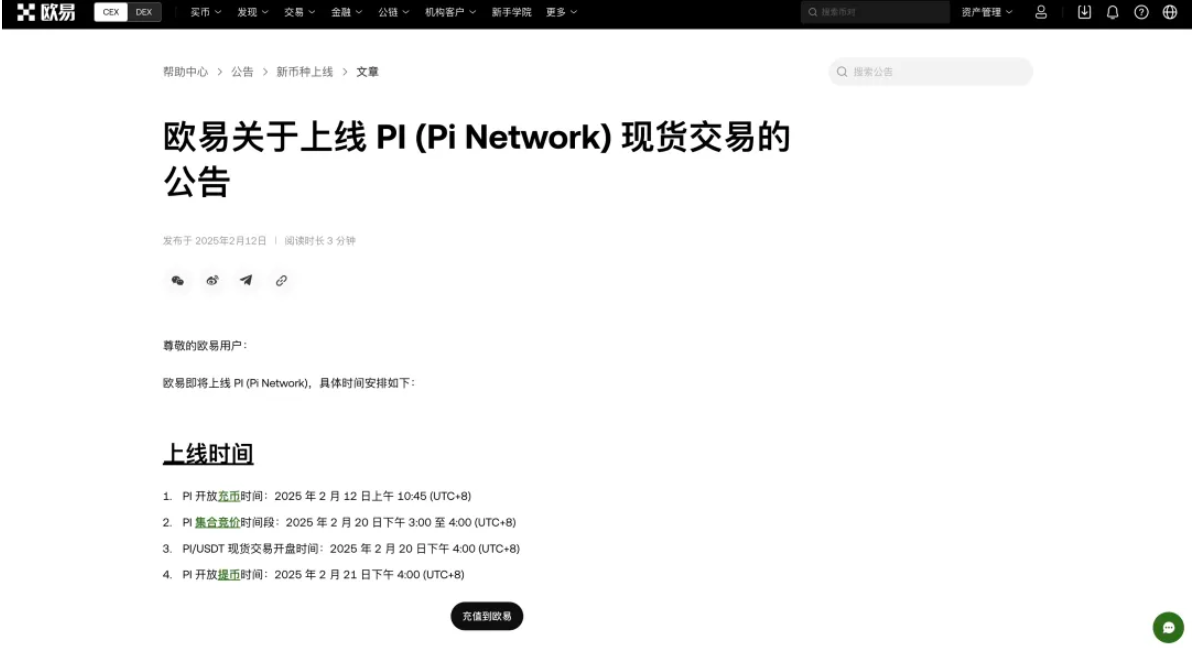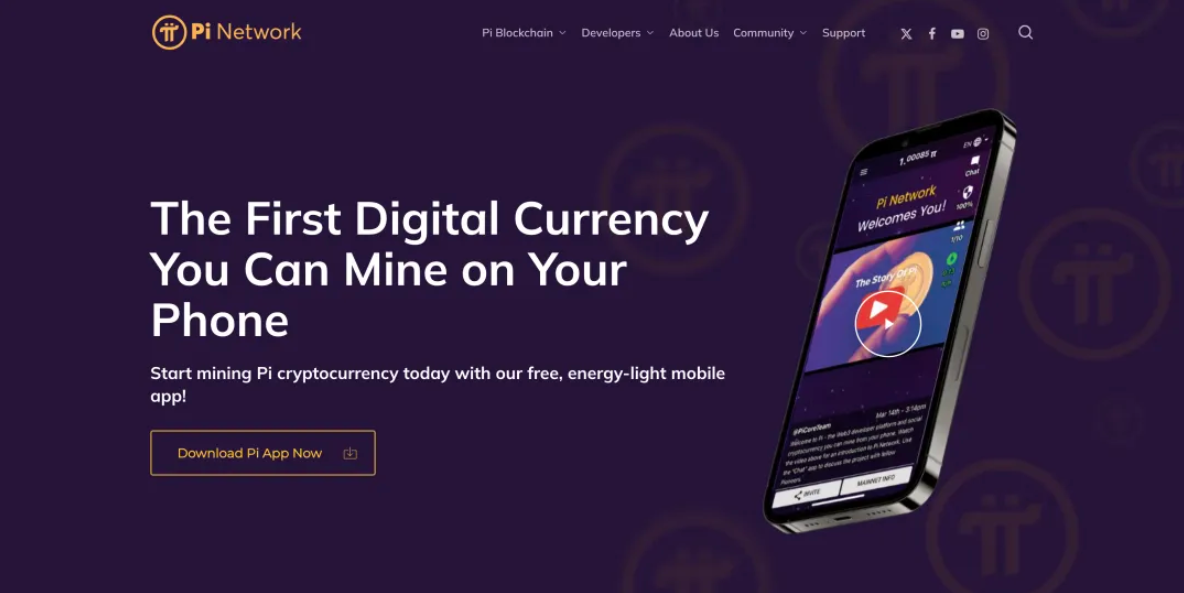Pi is about to be launched on the OKX exchange. Is it a pyramid scheme coin?

Reprinted from panewslab
02/19/2025·2MAuthors of this article: Iris, Xu Xiaohui
On February 12, 2025, OKX released an "inspiring" announcement: Ouyi's announcement on the launch of Pi (Pi Network) spot transactions.

According to the announcement, Pi Network, a highly controversial and huge crypto project in China, will finally officially launch the main network in 6 years. I believe that as soon as this announcement is released, a large number of domestic users will cheer. Finally, I can stop using love to generate electricity!
However, for Pi Network, the mainstream Web3 circle is rarely mentioned.
Regarding the launch of the main network, the well-known Web3 media Planet Daily wrote an article titled "The Countdown to the "King of Pyramid Selling" Pi main network. 60 million people who have been brainwashed for six years are about to "realize their dreams"? 》, which points out: Six years of sharpening a sword or a sickle? Pi is launched and becomes the "ultimate inspection site for IQ tax". The relevant information that can be retrieved on mainstream media has been mostly linked to keywords such as regulatory news and "pyramid schemes".
In addition, my country's regulatory authorities have become more harsh in their attitude towards Pi Network and related projects. For example, the Nantong police issued an announcement in April 2022, reminding the public to be wary of the risks of sending coins to mining; also in 2022, Ping An Sanming published an article "Organizing lectures, dinners... Sanming has a "π coin" scam, and many people have already "Stealing" to warn the public; then, local public security and relevant regulatory agencies have successively issued warning announcements/articles.
In fact, lawyer Mankun found that although official institutions have more tips on fraud issues, when it comes to Pi Network, most people criticize it as "Pangshi" and "pyramid schemes". Why is there such a statement?
Pi's "crazy" fission growth
From 2019 to the present, in 6 years, Pi Network has accumulated 60 million users with the "free mining + fission promotion" model, and its development speed is amazing. Among them, social fission promotion is the core growth method - users can get Pi coins by clicking on check-in every day, and at the same time, the mining speed can be increased by inviting new users.

Since there is no need to invest money in the entire process, the community promotion model is simple, low threshold, and easy to form community consensus, coupled with its team's long-term market expectation to create "high value in the future". Therefore, this model has spread rapidly around the world.
However, this growth model has also hit the red line of all pyramid schemes.
In his previous articles, Lawyer Mankun sorted out the essence and characteristics of pyramid schemes. The article points out that as long as the entry fee, downline development and hierarchical remuneration are met at the same time in business activities, it constitutes a pyramid scheme.
The fission pattern of Pi Network happens to be similar to this.
First, the income model depends on new recruitment . Pi's mining mechanism does not essentially rely on users' computing power, but is based on whether users continue to be active and invite newcomers. This means that users' income does not come from real production activities, but depends on whether they can bring more new users. This model can easily evolve into a typical "head-pulling" model rather than a real decentralized economic system.
Secondly, the market value is controlled by the team . Although Pi does not require users to pay fiat currency or crypto assets directly, its "threshold for obtaining tokens" is to bind personal information and complete KYC (identity authentication). The issuance process of KYC qualifications is controlled by the team and is even derived in some markets "Black Market KYC Service" has been released, forming "entry cost" in disguise. At the same time, the team has long restricted the circulation of Pi, making it impossible for users to buy and sell freely. The market value of the token depends entirely on when the team will open up trading permissions. This artificially created scarcity makes it more like a "Ponzi scheme" than a real Web3 project.
In addition, the hidden design of hierarchical compensation . On the surface, Pi users will not directly obtain the benefits of offline payments, but inviting new users can increase their mining speed, which is actually an implicit "hierarchical income". Users at different levels enjoy different token appreciation rights, while early joiners are in an advantageous position in the community, similar to the "pyramid structure" in the pyramid scheme model. This model of relying on community fission and encouraging hierarchical growth makes Pi more like a fission system with financial Ponzi attributes than a truly decentralized financial innovation.
Although Pi is called a pyramid scheme, it is undeniable that Pi's development has shown us an ultimate fission-like expansion capability. And this is exactly the capability that Web3 projects are scarce.
However, will all fission gameplay really touch the problem of pyramid schemes? Can other Web3 projects learn from the fission model?
Fission growth ≠ pyramid scheme
Since the development of traditional Internet, the way to attract new fission has long been played. But the core factor that really determines whether fission promotion is legal is actually the way users contribute their value .
Looking at the Web3 industry, many projects have tried similar promotion strategies, such as GameFi's task incentives, SocialFi's social fission, and even some projects themselves are task marketing platforms, which specifically provide gameplay for attracting new fissions. But to avoid being recognized as a pyramid scheme by regulators, Web3 projects need to be built on real user contributions and a transparent token economic system, rather than simply relying on new things to create value.
1. User growth = actual contribution
If Pi’s problem is that “fission rewards are directly linked to the number of new recruits”, then a compliant fission model must ensure that users’ rewards come from actual behavioral contributions, rather than simply attracting people , and cannot form up and down relationships and layers of relationships. Rewards for new commissions .
For example, Galxe uses "on-chain behavior incentives" that require users to complete on-chain interactions (such as governance voting, NFT holding) before they can receive rewards.
The core logic of these models is that fission promotion is only a means, and value contribution is the core . As long as the user's rewards are linked to actual contributions, rather than simply relying on the development of downlines, the risks of pyramid schemes can be avoided.
2. Transparent Token circulation mechanism
Another key problem with Pi is that the project party has long controlled the circulation of tokens, making it impossible for users to buy and sell freely, which makes the market completely restricted by team decisions, making it easy to form a Ponzi structure , and is easily recognized by regulators as market manipulation or even illegal fundraising. .
Therefore, a compliant fission growth model needs to have a more transparent and secure mechanism based on tokens, including actual usage scenarios, decentralization (i.e. not fully controlled by the team), and compliance registration and supervision.
Simply put, a truly compliant fission growth model must conform to the closed loop of value contribution → community fission → transparent market circulation , rather than attracting new profits → market hunger → speculative exit logic.
3. Community fission + DAO governance, alternative hierarchical remuneration
"Inviteers enjoy higher mining returns." This marketing method can be essentially considered an invisible hierarchical return and is easy to form a pyramid structure, which is also an obvious feature of Pi being considered a pyramid scheme. Therefore, compliant fission promotion needs to avoid this structure.
At present, some Web3 projects guide the value of community fission back to ecological contribution through the DAO governance model. In this way, the overall fission model is no longer a one-way hierarchical incentive, but a decentralized contribution mechanism to ensure that the growth brought about by fission is sustainable.
Summary of Lawyer Mankun
Pi Network once again proves to the Web3 industry that strong community fission is one of the strongest drivers of crypto market growth. However, its model also exposes the dilemma of Web3 growth - the growth of the value of the token is decoupled from the real economic contribution, and projects rely on users to attract new users to create bubble value. This model is often easily recognized by regulators as "pyramid schemes" or "pang". "The Scam".
At present, the global regulatory environment is becoming increasingly strict, and the logic of Web3 growth has long been separated from the previous "barbaric development" and is moving towards "compliance and fission". If you just copy the Pi mode without making any adjustments, the final result may not be the user bonus, but the heavy blow to the supervision.
Because, true innovation is not simply imitation, but finding ways to grow sustainably within the compliance framework.


 chaincatcher
chaincatcher
 jinse
jinse